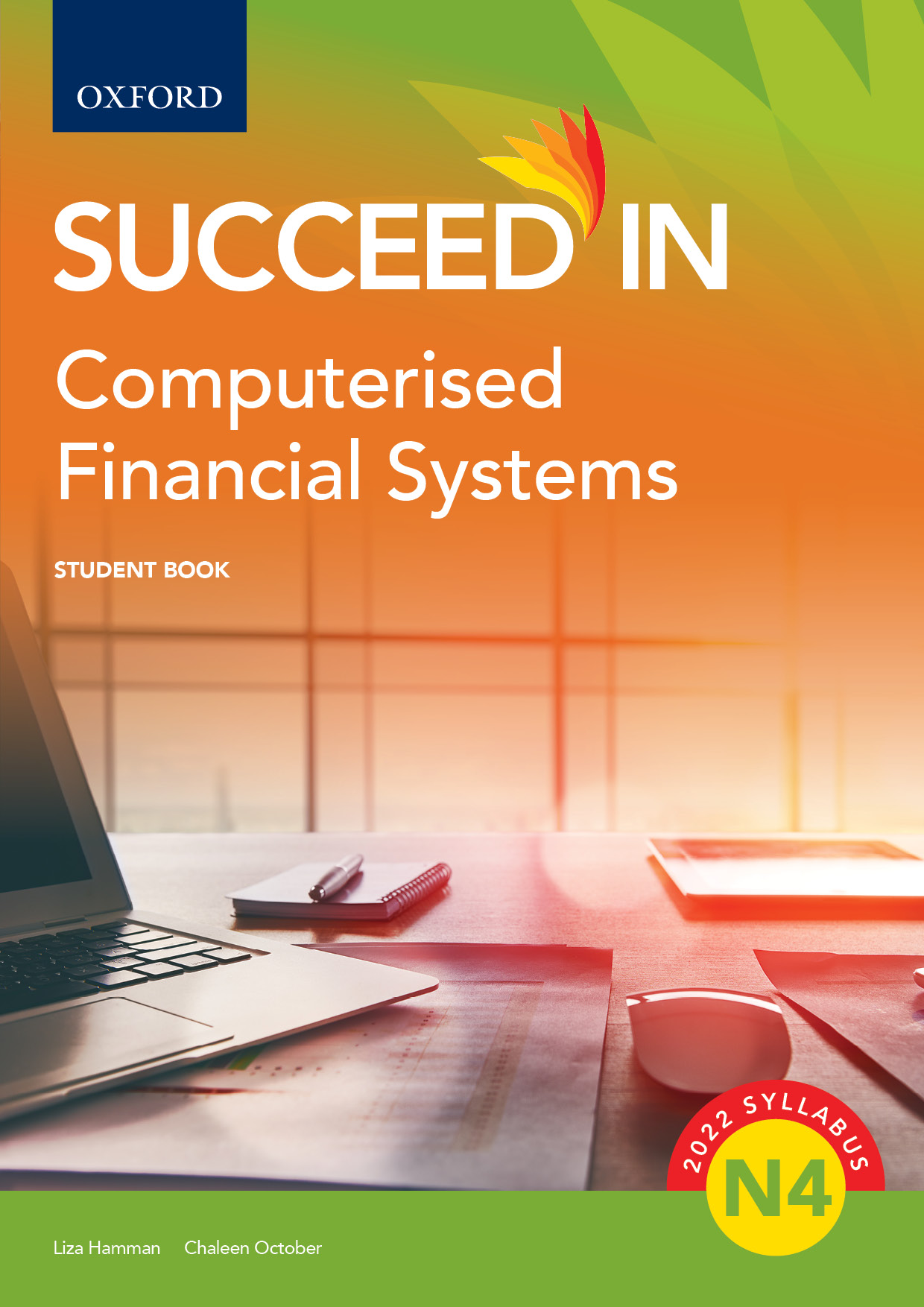Module 1: THE USE OF COMPUTERISED SYSTEMS AND COMPUTERISED ACCOUNTING ON A COMPUTER
Learning objectives
Starting point
Unit 1.1: The concept and functions of a computer
Unit 1.2: The components of a computer system
Unit 1.3: The characteristics of the selected accounting program
Unit 1.4: The use of a reference manual
Unit 1.5: The 'Help' function
What do you now know and where to next?
Revisiting learning objectives
Assessment
Module 2: MASTERING A WORD-PROCESSING PROGRAM
Learning objectives
Starting point
Unit 2.1: Computer proficiency
Unit 2.2: Word-processing functions
Unit 2.3: Using the 'Help' function
What do you now know and where to next?
Revisiting learning objectives
Assessment
Module
3: THEORY AND APPLICATION OF VALUE-ADDED TAX (VAT)
Learning objectives
Starting point
Unit 3.1: Description and registration of VAT
Unit 3.2: Legal requirements for input and output VAT
Unit 3.3: Types of VAT supplies
Unit 3.4: Calculation and accounting procedures regarding VAT
Unit 3.5: Completion of a tax return form
Unit 3.6: VAT compliance
Unit 3.7: Tax periods for VAT
Unit 3.8: Legal requirements for documents used in a VAT system
What do you now know and where to next?
Revisiting learning objectives
Assessment
Module 4: THE ACCOUNTING CYCLE AND SET-UP OF A NEW COMPANY AND PARAMETERS
Learning objectives
Starting point
Unit 4.1: The eight-step accounting cycle
Unit 4.2: Service and trading organisation transactions
Unit 4.3: Opening a new set of accounts and setting up company parameters
Unit 4.4: How to set up Subsidiary Journals (entry types)
Unit 4.5: Setting up of parameters for customers and
suppliers
Unit 4.6: Setting up of parameters for a continuous stock system
Unit 4.7: Creating General Ledger accounts with codes and parameters
Unit 4.8: Creating customer accounts with codes and parameters
Unit 4.9: Creating supplier accounts with codes and parameters
Unit 4.10: Setting up and creating service and stock items
Unit 4.11: Parameters for implementing computerised invoices
What do you now know and where to next?
Revisiting learning objectives
Assessment
Module 5: TAKE ON BALANCES AND PROCESSING OF CUSTOMER AND SUPPLIER TRANSACTIONS
Learning objectives
Starting point
Unit 5.1: Input of opening balances for General Ledger accounts
Unit 5.2: View and print General Ledger accounts transaction listings
Unit 5.3: Input of customer age analysis (Customer balances)
Unit 5.4: Input of supplier age analysis (Supplier balances)
Unit 5.5: Enter stock items at cost price in the stock system
Unit 5.6: View and
print inventory reports and master listings
Unit 5.7: Source documents
Unit 5.8: Input of credit purchases of trading inventory (stock purchases)
Unit 5.9: Input of non-stock purchases in the Supplier Journal
Unit 5.10: Returns to suppliers (stock purchases)
Unit 5.11: Returns to suppliers (non-stock purchases) in the Supplier Allowance Journal
Unit 5.12: View and print supplier invoices due
Unit 5.13: Cash and credit sales of trading stock
Unit 5.14: Returns by customers
Unit 5.15: View and print invoices due to customers
What do you now know and where to next?
Revisiting learning objectives
Assessment
Module 6: PROCESSING OF SUBSIDIARY JOURNALS AND BANK RECONCILIATION STATEMENT
Learning objectives
Starting point
Unit 6.1: Cash Book: petty cash
Unit 6.2: Cash Book payments
Unit 6.3: Cash Book receipts
Unit 6.4: Bank Reconciliation
Unit 6.5: Print outs
What do you now know and where to next?
Revisiting
learning objectives
Assessment
Module 7: SUNDRY ADJUSTMENTS
Learning objectives
Starting point
Unit 7.1: Correction of an error
Unit 7.2: Correction of stock value
Unit 7.3: Writing off bad debts
Unit 7.4: Interest on Customer accounts
Unit 7.5: Provision for depreciation
Unit 7.6: Other adjustments
Unit 7.7: Record Capital Contributions or Drawings
Unit 7.8: Print and update a journal
Unit 7.9: How to record profit or loss
What do you now know and where to next?
Revisiting learning objectives
Assessment
Module 8: VIEW AND PRINT FINANCIAL STATEMENTS AND ADDITIONAL REPORTS
Learning objectives
Starting point
Unit 8.1: Financial statements
Unit 8.2: Customer statements
Unit 8.3: Supplier remittance advice
Unit 8.4: The 'Note' facility
What do you now know and where to next?
Revisiting learning objectives
Assessment
Examination tips
Acknowledgements
Glossary
Index
